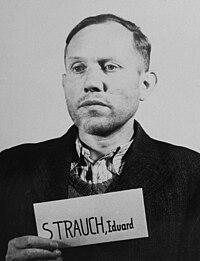| This article includes a list of general references, but it lacks sufficient corresponding inline citations. Please help to improve this article by introducing more precise citations. (July 2023) (Learn how and when to remove this message) |
| Eduard Strauch | |
|---|---|
 Strauch's mugshot after his indictment for the Nuremberg Military Tribunal (July 1947) Strauch's mugshot after his indictment for the Nuremberg Military Tribunal (July 1947) | |
| Born | 17 August 1906 (1906-08-17) Essen, Rhine Province, Prussia, German Empire |
| Died | 15 September 1955(1955-09-15) (aged 49) Uccle, Belgium |
| Occupation | Commander of Einsatzkommando 2 |
| Criminal status | Deceased |
| Motive | Nazism |
| Conviction(s) | U.S. Military Crimes against humanity War crimes Membership in a criminal organization Belgium War crimes |
| Trial | Einsatzgruppen Trial |
| Criminal penalty | Death |
Eduard Strauch (17 August 1906 – 15 September 1955) was a German Nazi SS functionary, commander of Einsatzkommando 2, commander of two Nazi organizations, the Security Police (German: Sicherheitspolizei), or Sipo, and the Security Service (German: Sicherheitsdienst, or SD), first in Belarus – then called White Russia or White Ruthenia – and later in Belgium. In October 1944, he was transferred to the militarised branch of the SS, the Waffen-SS.
Strauch was convicted for crimes against humanity in the Einsatzgruppen Trial and sentenced to death. Extradited to Belgium, he was again convicted and sentenced to death. However, Strauch was not executed since he was supposedly mentally ill. He died in a Belgian hospital in 1955.
Life
Born in Essen, Strauch first studied theology at the universities of Erlangen (now Erlangen-Nuremberg) and Münster, but changed his course of studies and graduated with a degree in jurisprudence. On 1 August 1931, he joined the Nazi Party (membership no. 623.392) and SA. On 1 December 1931, he became a member of the Nazi SS organization (membership no. 19.312). As of December 1934 he began working for the SD.
Crimes against humanity
At the beginning of the German invasion of the Soviet Union in June,1941, Strauch assumed command of a unit of the Einsatzgruppen. Strauch led Einsatzkommando 2, part of Einsatzgruppe A, which from 4 November 1941 was under the command of Franz Walter Stahlecker. On 30 November 1941, he participated, with 20 men under his command, in the murder of 10,600 Jews of Riga in the Rumbula forest near the city. As a reward for this "service" he was promoted to commander in Sipo and the SD and transferred to Belarus.
In July 1943, the Nazi general commissioner for White Russia reported on having had a conference with the "extremely capable chief of the SD, SS-Obersturmbannführer Dr. jur. Strauch", who had caused "the liquidation of 55,000 Jews in just the past 10 weeks alone." Strauch had difficulties within the SS. He and official Wilhelm Kube reportedly did not get along. Strauch's promotion to Standartenführer was denied. On 31 May 1944, he was appointed Sipo and SD commander in Belgium. In October 1944 Strauch was transferred to the SS military branch the Waffen-SS.
Trial and conviction
Despite an effort to sham mental illness, Strauch was convicted by the Nuremberg Military Tribunal in the Einsatzgruppen Trial for having a key role in the Rumbula and a number of other mass murders in Eastern Europe. On 9 April 1948, Presiding judge Michael Musmanno pronounced the tribunal's sentence on Strauch:
Defendant EDUARD STRAUCH, on the counts of the indictment on which you have been convicted, the Tribunal sentences you to death by hanging.
Unlike his co-defendants Otto Ohlendorf and Paul Blobel, Strauch did not hang. Instead, he was handed over to authorities in Belgium, where he had committed other crimes, for trial. He was once more convicted and sentenced to death, but this sentence likewise was never carried out since the Belgians were convinced that he was indeed mentally ill. Strauch died in custody on 15 September 1955 in a hospital in Uccle, Belgium.
Notes and references
- Einsatzgruppen judgment, at 563-567
- Einsatzgruppen judgment, at 589
- (in Italian)Eduard Strauch, biography and photo at Olokaustos.org Archived 11 February 2002 at the Wayback Machine
References
- Trials of War Criminals before the Nuernberg Military Tribunals under Control Council Law No. 10, Nuernberg, October 1946 - April 1949, Volume IV, ("Green Series) (the "Einsatzgruppen case") also available at Mazel library (well indexed HTML version)
External links
| The Holocaust in Latvia | |
|---|---|
| Crimes | |
| Victims | |
| Perpetrators |
|
| Nazi occupation and organizations | |
| Collaborators |
|
| Ghettos and camps | |
| Documentation | |
| Concealment | |
| War crimes investigations and trials | |
| Righteous Among the Nations | |
| Memorials | |
| Related articles | |
| Einsatzgruppen and Einsatzkommandos | |||||||||||||||||
|---|---|---|---|---|---|---|---|---|---|---|---|---|---|---|---|---|---|
| People |
| ||||||||||||||||
| Groups |
| ||||||||||||||||
| Crimes |
| ||||||||||||||||
| Records | |||||||||||||||||
- 1906 births
- 1955 deaths
- Military personnel from Essen
- People from the Rhine Province
- Nazi Party politicians
- SS and Police Leaders
- SS-Obersturmbannführer
- Einsatzgruppen personnel
- Sturmabteilung personnel
- Young German Order members
- Holocaust perpetrators in Belgium
- Holocaust perpetrators in Latvia
- Holocaust perpetrators in Belarus
- German police officers convicted of crimes against humanity
- German prisoners sentenced to death
- Prisoners sentenced to death by Belgium
- Nazis who died in prison custody
- Waffen-SS personnel
- Lawyers in the Nazi Party
- Prisoners who died in Belgian detention
- People sentenced to death by the United States Nuremberg Military Tribunals